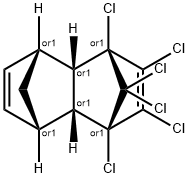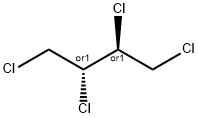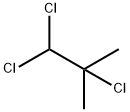ISODRIN
Synonym(s):1,2,3,4,10,10-Hexachloro-1,4,4a,5,8,8a-hexahydro-endo,endo-1,4:5,8-dimethanonaphthalene
- CAS NO.:465-73-6
- Empirical Formula: C12H8Cl6
- Molecular Weight: 364.91
- MDL number: MFCD00135588
- EINECS: 207-366-2
- SAFETY DATA SHEET (SDS)
- Update Date: 2024-12-18 14:07:02

What is ISODRIN?
Chemical properties
Crystals.
The Uses of ISODRIN
Insecticide.
General Description
Solid. ISODRIN is no longer used as a pesticide. Isomer of aldrin.
Reactivity Profile
ISODRIN is related to aldrin. (nonspecific -- Aldrin) When heated to decomposition ISODRIN emits toxic fumes of chlorine. Unstable, reactions induced by light or acid. [EPA, 1998].
Hazard
Toxic, use may be restricted.
Health Hazard
ISODRIN is classified as extremely toxic. Probable oral lethal dose for humans is 5-50 mg/kg or between 7 drops and 1 teaspoonful for a 70 kg (150 lb.) person. It causes renal damage and hyperactivity of sympathetic nervous system.
Fire Hazard
(Non-Specific -- Aldrin) ISODRIN may burn but may not ignite readily. Container may explode in heat of fire. Fire and runoff from fire control water may produce irritating or poisonous gases. Material is related to aldrin. (Non-Specific -- Aldrin) When heated to decomposition ISODRIN emits toxic fumes of chlorine. Unstable, reactions induced by light or acid.
Properties of ISODRIN
| Melting point: | 239-241 °C (lit.) |
| Boiling point: | 450.9°C (rough estimate) |
| Density | 1.5043 (rough estimate) |
| refractive index | 1.5840 (estimate) |
| Flash point: | 11 °C |
| storage temp. | APPROX 4°C
|
| solubility | Chloroform (Sparingly), Methanol (Slightly) |
| form | neat |
| BRN | 2509251 |
| Stability: | Light Sensitive |
| EPA Substance Registry System | Isodrin (465-73-6) |
Safety information for ISODRIN
| Signal word | Danger |
| Pictogram(s) |
 Skull and Crossbones Acute Toxicity GHS06  Environment GHS09 |
| GHS Hazard Statements |
H410:Hazardous to the aquatic environment, long-term hazard |
| Precautionary Statement Codes |
P262:Do not get in eyes, on skin, or on clothing. P273:Avoid release to the environment. P280:Wear protective gloves/protective clothing/eye protection/face protection. |
Computed Descriptors for ISODRIN
New Products
Tert-butyl bis(2-chloroethyl)carbamate (S)-3-Aminobutanenitrile hydrochloride N-Boc-D-alaninol N-BOC-D/L-ALANINOL N-octanoyl benzotriazole 4-Hydrazinobenzoic acid 3,4-Dibenzyloxybenzaldehyde Electrolytic Iron Powder 1,1’-CARBONYLDIIMIDAZOLE R-2-BENZYLOXY PROPIONIC ACID 4-HYDROXY BENZYL ALCOHOL 1,1’-CARBONYLDI (1,2-4 TRIAZOLE) S-2-CHLORO PROPIONIC ACID (2-Hydroxyphenyl)acetonitrile 4-Bromopyrazole 5-BROMO-2CYANO PYRIDINE 5,6-Dimethoxyindanone 5-broMo-2-chloro-N-cyclopentylpyriMidin-4-aMine 3-(Hydroxymethyl)benzoate N-Boc-2-chloroethylamine 1-Bromo-2-methoxy-3-nitrobenzene N-Methyl-3-cyclopenten-1-amine 2-Bromo-3-hydroxybenzaldehyde 1H-indazole-5-carboxamideRelated products of tetrahydrofuran








You may like
-
 7441-43-2 98%View Details
7441-43-2 98%View Details
7441-43-2 -
 1260741-78-3 6-Bromo-3-iodo-1-methyl-1H-indazole 98%View Details
1260741-78-3 6-Bromo-3-iodo-1-methyl-1H-indazole 98%View Details
1260741-78-3 -
 (3-Benzyloxypropyl)triphenyl phosphonium 98%View Details
(3-Benzyloxypropyl)triphenyl phosphonium 98%View Details
54314-85-1 -
 4-bromo-3,5-dimethylbenzenesulfonyl chloride 1581266-79-6 98%View Details
4-bromo-3,5-dimethylbenzenesulfonyl chloride 1581266-79-6 98%View Details
1581266-79-6 -
 2490430-37-8 98%View Details
2490430-37-8 98%View Details
2490430-37-8 -
 N-(5-Amino-2-methylphenyl)acetamide 5434-30-0 98%View Details
N-(5-Amino-2-methylphenyl)acetamide 5434-30-0 98%View Details
5434-30-0 -
 124371-59-1 98%View Details
124371-59-1 98%View Details
124371-59-1 -
 53857-52-2 98%View Details
53857-52-2 98%View Details
53857-52-2